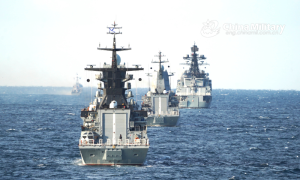Chinese Russian Naval Ships Alaska
The presence of Chinese and Russian naval ships near Alaska has recently emerged as a pivotal geopolitical event. This article delves into the intricacies of this situation, examining the underlying motives, potential consequences, and the broader impact on global security.
The Strategic Importance Chinese Russian naval ships Alaska
A Gateway to the Arctic
Alaska’s geographical proximity to the Arctic region has transformed it into a crucial gateway. As the Arctic ice melts due to climate change, new shipping routes are opening, making Alaska a vital point of access for nations seeking shorter maritime passages between Europe and Asia.
Resource Abundance
Beyond its strategic location, Alaska boasts vast reserves of oil, natural gas, minerals, and fisheries. These resources have attracted the attention of both China and Russia, prompting their strategic interest in the region.
Economic Interests and Resource Exploration
Energy Resources Race
The presence of Chinese and Russian naval ships near Alaska underscores the race for energy resources. Both nations are eyeing the potential for oil, natural gas, and mineral extraction as the region becomes more accessible due to melting ice.
Economic Impacts
The exploitation of Arctic resources could provide a significant economic boost for both China and Russia. Access to new trade routes and resources can stimulate economic growth and enhance their global influence.
Environmental Challenges and Conservation
Climate Change Concerns
The increased naval activities near Alaska have raised concerns about the environmental impact of these operations. As climate change accelerates in the Arctic, ensuring sustainable practices becomes crucial to protect the fragile ecosystem.
Collaborative Conservation Efforts
chinese russian naval ships alaska , and other nations involved in Arctic activities are under pressure to demonstrate their commitment to environmental conservation. Collaborative efforts are necessary to prevent irreversible damage to the Arctic’s unique biodiversity.
Chinese Naval Activities and Ambitions
Expansion of Naval Reach
China’s rapidly modernizing naval forces have enabled it to extend its operational sphere well beyond its traditional waters. The presence of Chinese naval ships near Alaska signifies the nation’s ambitions to become a global maritime power, capable of safeguarding its interests on a worldwide scale.
The Arctic Silk Road
China’s Belt and Road Initiative (BRI) has expanded to encompass the Arctic region, referred to as the “Arctic Silk Road.” Chinese investments and infrastructure projects in the region align with its long-term goal of facilitating trade and connectivity through the Arctic. Also discover more The Remarkable Crimean Bridge
Russian Naval Presence and Assertiveness
Securing Sovereignty
Russia’s assertive naval presence near Alaska underscores its claims over the Northern Sea Route and the Arctic waters. This assertion of sovereignty is coupled with Russia’s desire to exploit the region’s vast underwater resources.
Military Demonstrations
Russian naval activities near Alaska involve military exercises that display the nation’s naval prowess. These demonstrations serve as a reminder of Russia’s military capabilities and its determination to protect its interests.

Geopolitical Dynamics
Strengthening China-Russia Ties
The joint presence of Chinese and Russian naval ships near Alaska symbolizes the deepening strategic partnership between the two nations. It represents their shared interests in countering Western influence and consolidating their geopolitical positions.
U.S. Response and Concerns
The United States views the presence of foreign naval ships near Alaska as a challenge to its regional interests. Tensions have escalated as the U.S. seeks to uphold its security commitments and maintain influence in the Arctic region.
Potential Implications
Environmental Impact
The increased naval activities near Alaska pose environmental concerns due to potential oil spills, marine life disturbances, and the overall fragility of the Arctic ecosystem. The need for sustainable practices and disaster response mechanisms is paramount. With naval forces from different nations in close proximity, the risk of inadvertent clashes or misunderstandings increases. Effective communication and de-escalation protocols are vital to prevent unintentional conflicts.
Maritime Security and Collaboration
Joint Military Exercises
The joint naval exercises conducted by chinese russian naval ships alaska near Alaska serve multiple purposes. Beyond displaying their military capabilities, these exercises are a demonstration of their commitment to collaboration in maintaining regional security and countering potential threats.
Coordination in Unison
China and Russia’s synchronized naval activities highlight their ability to coordinate and strategize effectively, not only in terms of military maneuvers but also in aligning their diplomatic efforts to achieve shared goals.
Strained U.S.-China Relations
The presence of Chinese naval ships near Alaska has further strained the already complex relations between China and the United States. The U.S. views this as an assertion of power in a region it considers vital for its own interests.
Russia’s Role as a Balancer
Russia’s dual engagement with both China and the United States in the Arctic region positions it as a potential balancer of power. Russia’s ability to engage in diplomacy with multiple players is a testament to its strategic dexterity.
Future Scenarios and Uncertainties
Potential Cooperation
While the current scenario highlights geopolitical competition, there is potential for collaboration among China, Russia, and other Arctic nations. The shared challenges of climate change, resource management, and maritime security may drive them to find common ground.
Complex Alliances
The dynamics of alliances and partnerships in the Arctic region are likely to evolve. As nations adjust their strategies, unforeseen alliances and realignments could reshape the geopolitical landscape.

Conclusion
The presence of Chinese and Russian naval ships near Alaska has far-reaching implications for global politics, security, and environmental stability. As the region witnesses a complex interplay of interests, nations must balance their strategic ambitions with responsible engagement, safeguarding the fragile Arctic ecosystem while addressing geopolitical concerns.
FAQs
Q1: What is the main objective behind China’s Arctic Silk Road initiative?
A: China aims to create new trade routes through the Arctic, facilitating greater connectivity and access to resource-rich regions.
Q2: How does the U.S. view China and Russia’s naval activities near Alaska?
A: The U.S. sees these activities as a challenge to its influence and security interests in the Arctic, leading to increased vigilance.
Q3: What measures are in place to prevent accidental conflicts between naval forces near Alaska?
A: Nations involved have established communication channels and protocols to reduce the risk of misunderstandings and escalation.
Q4: What potential economic benefits does the Arctic region offer to China and Russia?
A: The Arctic’s resource richness and emerging shipping routes offer opportunities for resource extraction, trade, and economic growth.
Q5: How does the melting Arctic ice impact global maritime trade routes?
A: Melting ice opens up new routes, significantly reducing the distance and time required for shipping between Asia and Europe.
